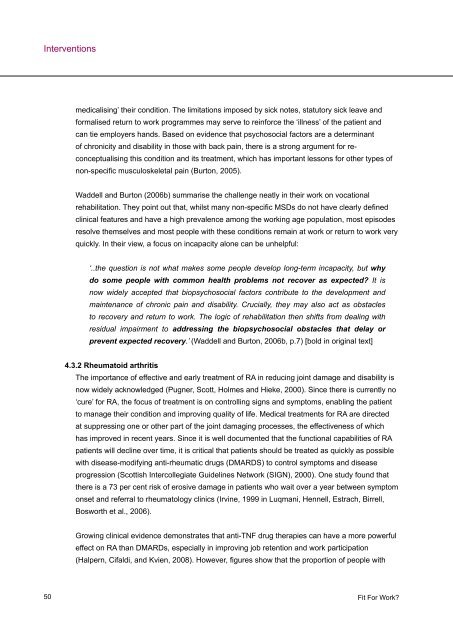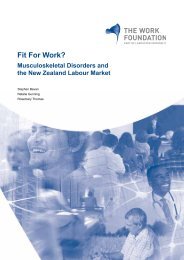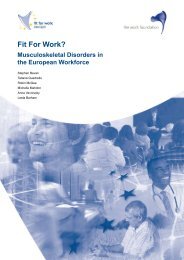FfW Bulgarian report (English language) - Fit for Work Europe
FfW Bulgarian report (English language) - Fit for Work Europe
FfW Bulgarian report (English language) - Fit for Work Europe
You also want an ePaper? Increase the reach of your titles
YUMPU automatically turns print PDFs into web optimized ePapers that Google loves.
Interventions<br />
50<br />
medicalising’ their condition. The limitations imposed by sick notes, statutory sick leave and<br />
<strong>for</strong>malised return to work programmes may serve to rein<strong>for</strong>ce the ‘illness’ of the patient and<br />
can tie employers hands. Based on evidence that psychosocial factors are a determinant<br />
of chronicity and disability in those with back pain, there is a strong argument <strong>for</strong> reconceptualising<br />
this condition and its treatment, which has important lessons <strong>for</strong> other types of<br />
non-specific musculoskeletal pain (Burton, 2005).<br />
Waddell and Burton (2006b) summarise the challenge neatly in their work on vocational<br />
rehabilitation. They point out that, whilst many non-specific MSDs do not have clearly defined<br />
clinical features and have a high prevalence among the working age population, most episodes<br />
resolve themselves and most people with these conditions remain at work or return to work very<br />
quickly. In their view, a focus on incapacity alone can be unhelpful:<br />
‘..the question is not what makes some people develop long-term incapacity, but why<br />
do some people with common health problems not recover as expected? It is<br />
now widely accepted that biopsychosocial factors contribute to the development and<br />
maintenance of chronic pain and disability. Crucially, they may also act as obstacles<br />
to recovery and return to work. The logic of rehabilitation then shifts from dealing with<br />
residual impairment to addressing the biopsychosocial obstacles that delay or<br />
prevent expected recovery.’ (Waddell and Burton, 2006b, p.7) [bold in original text]<br />
4.3.2 Rheumatoid arthritis<br />
The importance of effective and early treatment of RA in reducing joint damage and disability is<br />
now widely acknowledged (Pugner, Scott, Holmes and Hieke, 2000). Since there is currently no<br />
‘cure’ <strong>for</strong> RA, the focus of treatment is on controlling signs and symptoms, enabling the patient<br />
to manage their condition and improving quality of life. Medical treatments <strong>for</strong> RA are directed<br />
at suppressing one or other part of the joint damaging processes, the effectiveness of which<br />
has improved in recent years. Since it is well documented that the functional capabilities of RA<br />
patients will decline over time, it is critical that patients should be treated as quickly as possible<br />
with disease-modifying anti-rheumatic drugs (DMARDS) to control symptoms and disease<br />
progression (Scottish Intercollegiate Guidelines Network (SIGN), 2000). One study found that<br />
there is a 73 per cent risk of erosive damage in patients who wait over a year between symptom<br />
onset and referral to rheumatology clinics (Irvine, 1999 in Luqmani, Hennell, Estrach, Birrell,<br />
Bosworth et al., 2006).<br />
Growing clinical evidence demonstrates that anti-TNF drug therapies can have a more powerful<br />
effect on RA than DMARDs, especially in improving job retention and work participation<br />
(Halpern, Cifaldi, and Kvien, 2008). However, figures show that the proportion of people with<br />
<strong>Fit</strong> For <strong>Work</strong>?







